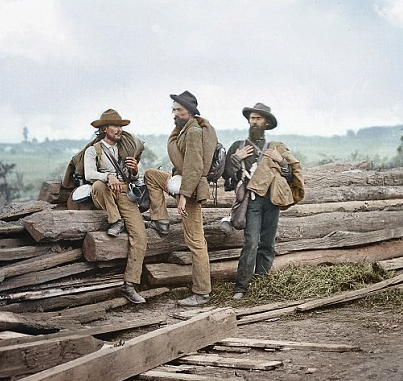This below article was graciously contributed by Dr. Terry Jones.
On
November 20, 1894, the newspaper Gettysburg Compiler reported that a delegation of Louisiana Confederate veterans had
arrived in town to help the Gettysburg National Park Commission locate the
positions the Louisiana troops occupied during the battle. The Louisiana veterans were the first state
delegation to begin work with the commission.
The veterans included Pvt. Eugene H. Levy of the Donaldsonville
Artillery; Capt. Andrew J. Hero of the Washington Artillery; Lt. Col. David
Zable of the 14th Louisiana; Sgt. Hugh H. Ward of the 7th
Louisiana; Corpl. Albert M. Levy of the Louisiana Guard Battery; and Sgt. Maj.
C. L. C. Dupuy of the Washington Artillery.
The Louisianians worked with John B. Bachelder, who devoted his life to
studying and preserving the battlefield, and park commissioner Major William
Robbins of the 4th Alabama and commission chairman Brevet Lt. Col.
John P. Nicholson of the 28th Pennsylvania.
“CONFEDERATES MARKING
POSITIONS.”
Louisianaa the first to Send a Commission
As reported in our last, the Louisiana Commission, to locate positions
of their troops on this battlefield, arrived on Wednesday, the party being
composed of Eugene Levy, And. Hero, David Zable, H. H. Ward, A. M. Levy and C.
L. C. Dupuy, and quartering at the Eagle.
Col. Bachelder and Major Robbins, of the Government Commission, the same
afternoon with the visitors, started on a tour of the Field, covering not only
the positions of the commands they represented
but the general movements of both armies. Col. Nicholson of the Commission was also with
them during part of their visit.
Louisiana had in this engagement 10 regiments, 5 each in Hays' and
Nichols’ brigades, besides 7 batteries. In
locating their positions the party drove out the Harrisburg road and a veteran
of Green's battery, Louisiana Guard artillery, quickly recognized their
position on the edge of a strip of woods on the southeast side of the road,
beyond the Bender farm. This elevated site
enabled the party to recognize the ground occupied by the troops of Hays'
brigade of infantry and Jones' battalion of artillery. Two of the rifled cannon of Green's battery
were added to Gen. Wade Hampton's cavalry and participated in the battle near
Hunterstown and also in the cavalry fight on the Rummel farm. The infantry brigade of Hays supported and
followed Gen. Gordon's
brigade and formed on East Middle street, connecting with Hoke's
brigade, which extended to the Culp buildings. On the night of the 2d Hays' brigade moved out
of town and attacked the remnant of Barlow's division on East Cemetery Hill.
The party drove out Baltimore street, and along the Winebrenner lane,
where a representative of Hays' brigade recognized the point where the 7th
Louisiana infantry crossed the lane, south of where the 75th Ohio infantry
monument now stands. One of the party
reached the Ricketts guns and engaged in the hand-to-hand contest over these
guns.
In order to locate the Nichols brigade regiments the party drove out
the Bonneauville road to the old Daniel Lady farm, where Gen. Lee spent the
night of July 1st, 1863. Col. Zable,
who commanded the 14th infantry, represented the brigade, and showed how they
passed over the Christian Benner farm, crossed Rock creek and took position on
the slope of Culp's Hill, about 150 feet below where the 29th [?] Ohio monument
stands, recognizing the position by the rocks.
They were in the engagements of
the night of the 2d and morning of the 3d.
The above tours occupying Wednesday and Thursday.
On Friday the party visited the first day's operations, where Col. Levy
described the movements of Maurin's battery of the Donaldson artillery. They drove out the Chambersburg pike and
placed the stake 300 yards south of Herr's tavern, on the crest of the ridge,
where they relieved one of the batteries of Pegram's battalion. They then drove to the lane back of the Theo.
Seminary and turned to the right, passing the old Shultz property, and marked
positions of 2d and 3d days in the open field in front of and a little to the
north of Miss Maria Shultz's cottage.
The positions of Miller's battery, of Eshleman's New Orleans battalion,
Washington artillery, were next visited. This battery moved along the Ridge and
bivouacked in the field in rear of Henry Spangler's woods. During the night they moved to the Emmitsburg
road with the other three batteries of the battalion. They went into position in Sherly's orchard, east
of the barn, 100 yards from the Emmitsburg road, the line of batteries extending
across the Emmitsburg road at the Smith place, and continuing to and beyond the Rogers house. This is the line of artillery which carried on
the Confederate part of that terrific cannonading which preluded the Pickett
charge, the two guns which opened it being under command of Lieut. And. Hero,
and located in the Sherly orchard.
During their visit, which lasted until Saturday evening, the visitors
were shown the new avenue being built along the Confederate line and expressed
their admiration of the work.
Col. Bachelder has for years been advocating the marking of both lines
of battle and through his efforts this first move in that direction has been
made. It is the confident expectation
that others of the Confederate states will follow and thus complete the marking
of this the most important battle of the late war.


